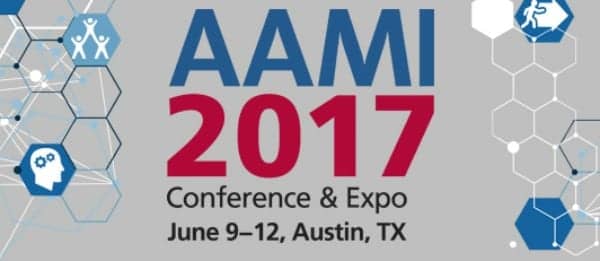During the AAMI 2017 Conference & Expo, set to run June 9-12 in Austin, HTM professionals will have the opportunity to learn what they need to stay on top of the latest innovations, advances, and risks. The Expo will allow attendees to see the latest upgrades and advances in medical technology from nearly 200 manufacturers.
“The biggest challenge for healthcare technology moving forward is to fully integrate these complex systems into the patient care workflow while ensuring that the quality of care provided by healthcare professionals is not diminished, and that the safety and security of these systems are not compromised and vulnerabilities are not exploited by those who would do harm to the patients or the caregivers,” says Chuck Sidebottom, managing partner of PPO Standards LLC and former AAMI Board chair.
Throughout AAMI 2017, industry experts and leaders will provide practical guidance and insights on the biggest trends and challenges in the healthcare technology sector, such as:
Moving Big Data to the Bedside
What if we could foresee a patient’s deterioration and take action to prevent it? What if the impending illness was so severe and the patients so vulnerable that this prediction would save their lives? And what if all we needed was little more than the medical devices and data that we already have? This isn’t part of some hypothetical future. This is a reality at the University of Virginia (UVA).
During the opening general session, J. Randall Moorman, a clinical cardiologist and UVA professor of internal medicine, physiology, and biomedical engineering, will discuss how he and his colleagues have turned more than 100 terabytes of data collected from continuous electronic monitoring into a “risk estimation device” for deadly conditions, such as sepsis in premature infants and hemorrhage and acute lung failure in adults.
I am completely committed to this idea that there are illnesses that we can detect early by analyzing the data that we already have,” Moorman says.
Cybersecurity
In hospitals today, it would be difficult to find medical device technology that does not critically depend on computer software. Network connectivity and wireless communication have transformed the delivery of patient care. But connectivity comes at a price—vulnerability to hackers, viruses, and other malware.
During the Dwight E. Harken Memorial Lecture, Kevin Fu, CEO and chief scientist of Virta Labs, Inc. and an associate professor at the University of Michigan where he directs the Archimedes Center for Medical Device Security and the Security and Privacy Research Group, plans to probe the risks, benefits, and regulatory issues for medical device cybersecurity and provide insight into the development of trustworthy medical device software.
“I hope that people will come out of my presentation with a less sensational view of the issues and a more optimistic view of the future of medical device security,” Fu says. “It’s not about eliminating risk but about controlling and managing risk. It can be done—it’s not impossible.”
Stricter Joint Commission Requirements
On the final day of AAMI 2017, George Mills, director of engineering at The Joint Commission (TJC), will take the stage to provide the latest information on TJC’s activities, discuss its plans, and explain how these will impact healthcare facilities. Attendees also will have the opportunity to pose their questions and concerns directly to Mills.
For many HTM professionals, this popular standing-room-only session will be a prime opportunity to gain clarification on TJC’s new maintenance standards and get advice for compliance.
A number of the education breakout sessions during the conference also will focus on this issue, including best practices for developing an alternative equipment maintenance program and how to demonstrate the safety and effectiveness of device maintenance and management programs to accreditation organizations and regulatory agencies.





